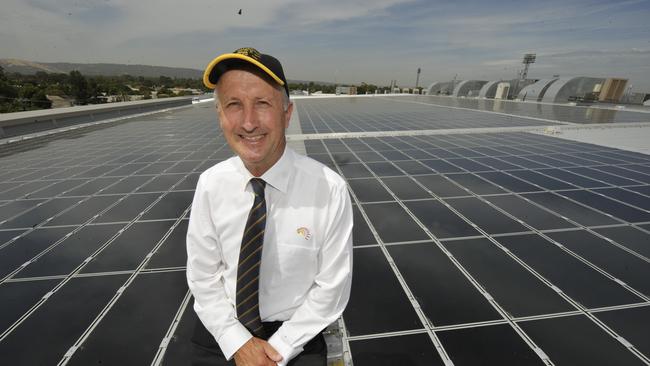South Australia well-placed to be a leader in microgrid technology
With microgrids at the Adelaide Showground, Adelaide Airport and the SA Produce Market, the state has an opportunity to be a leader in the technology.

SA Business
Don't miss out on the headlines from SA Business. Followed categories will be added to My News.
- Climate change ‘biggest challenge’ of our generation
- Prizes, discounts, freebies: Check out the latest subscriber rewards
South Australia has a large challenge but also an opportunity to be a leader in microgrid technology application, Schneider Electric Executive Vice President, International Operations Luc Remont says.
Speaking on the sidelines of the French company’s global Innovation Summit in Barcelona, Mr Remont said the extended nature of the electricity grids in SA and WA, servicing remote communities and mining operations, meant they were well suited to an evolution to microgrid use.
This could involve predominantly wind and solar power generation, coupled with local storage, reducing the need for expensive grid connections which can run to hundreds of millions of dollars.
SA already has a number of microgrids, which can be run either as part of the overall electricity grid, as “islands” which are self-sufficient, or a combination of both.
In March last year the South Australian Produce Market at Pooraka announced a $10.5 million program, backed with a $2.5 million State Government grant, to set up a microgrid which would save it $500,000 a year in costs and prevent expensive power outages.
That ongoing project includes a 4.2 megawatt lithium-ion battery, a 2.5 megawatt solar PV system comprising 6500 solar panels and a 2.5 megawatt on-site generator, all connected electrically with fibre-optic cable and controlled by a smart control and switching system.
There are also microgrids at the Royal Adelaide Showground and the Adelaide Airport. Mr Remont said SA’s high penetration of renewables and the characteristics of the energy grid meant it was well placed to be a global trend-setter.

“South Australia probably stands today as the most advanced place in the world in terms of managing a very decentralised generation capability, decentralised down to the final user, with (large numbers of) houses already equipped with rooftop generation capabilities, which is frankly unique in the world.
“And, of course, this leads to a big opportunity and a big challenge. The big opportunity is that it makes electricity available during the day for free, which means there is no viable cost attached to that, and many countries in the world would fight for that.
“And, of course, there is a big challenge, which is that there are so many generators in the grid that there is instability attached to that.”
This presented challenges balancing inputs to the grid with customer needs.
“It’s a unique challenge that South Australia is facing first, globally, but in my view represents where the world is going,” Mr Remont said.
“I see South Australia today as the cutting edge.’’
The Federal Government has expressed interest in microgrid technology, announcing in March a Regional and Remote Communities Reliability fund which has committed $50.4 million to support up to 50 off-grid and “fringe of grid” communities to investigate the viability of establishing a microgrid. The program has already funded the Daintree microgrid program, which aims to be the first powered solely by renewable energy.
MORE NEWS
KI groups splintered on timber port plan
That program involves residents with rooftop solar being credited for their power, which will be fed into the microgrid and used to create hydrogen, which will in turn be used to power generators. The project was granted $990,500 to progress it to “shovel-ready” status in 12 months from that date.
“The grant will also support investigation of new ownership and funding models for the deployment of the Daintree microgrid,” Federal Energy Minister Angus Taylor said at the time. The Daintree project has its critics, and a Queensland State Government report released last week claims power costs would increase by $11,000 to $15,000 per household using the microgrid solution. Daintree Renewable Energy president Russell O’Doherty said the report “was full of holes”.
The author travelled to Barcelona as a guest of Schneider Electric.

